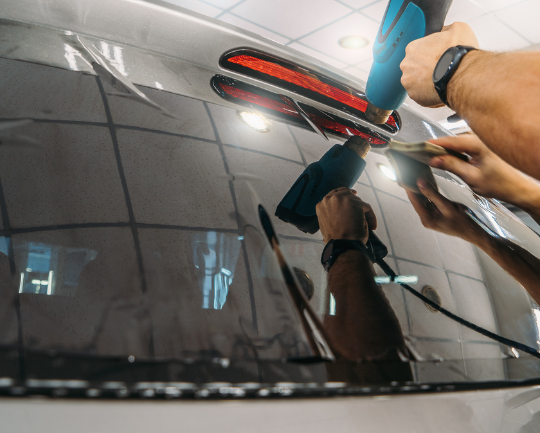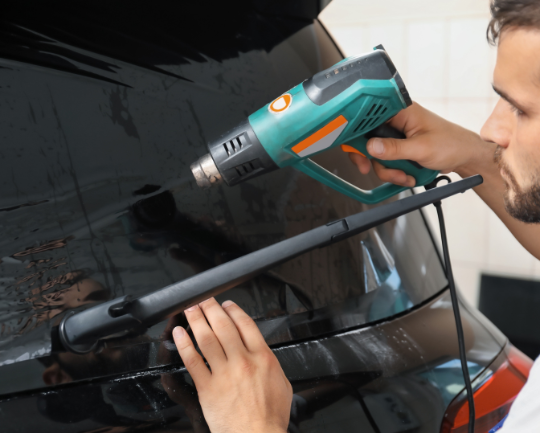In a world where environmental consciousness is becoming increasingly crucial, every small step toward sustainability counts. One such often overlooked yet impactful measure is window tinting. Beyond its aesthetic appeal and privacy benefits, window tinting offers a host of environmental advantages that are worth exploring. From reducing energy consumption by maintaining optimal indoor temperatures to mitigating harmful UV rays that contribute to climate change, the environmental benefits of window tinting are vast. Additionally, by minimizing the need for excessive air conditioning and heating, window tinting helps lower carbon emissions, contributing to cleaner air and a healthier planet. This blog delves deeper into the lesser-known ecological perks of window tinting, shedding light on how this simple solution can make a significant difference in our efforts towards a more sustainable future.
The Role of Window Tinting in Sustainability
In the pursuit of sustainable living and construction practices, every element of design and technology plays a crucial role. Window tinting, often associated with style and privacy, also has a significant impact on sustainability efforts. Beyond enhancing aesthetics, window tinting contributes to energy efficiency, resource conservation, and environmental protection.
 Energy Efficiency and Reduced Carbon Footprint:
Energy Efficiency and Reduced Carbon Footprint:
Window tinting acts as a shield against solar radiation, preventing excess heat from entering buildings during hot seasons and retaining warmth during colder months. By moderating indoor temperatures, window tinting reduces reliance on heating, ventilation, and air conditioning (HVAC) systems, thereby lowering energy consumption and associated carbon emissions. This energy efficiency aspect not only benefits individual households but also contributes to broader environmental conservation efforts by mitigating the overall demand for fossil fuels.
Preservation of Interior Elements
Ultraviolet (UV) rays from the sun can cause fading and deterioration of interior furnishings, such as carpets, furniture, and artwork. Window tinting serves as a protective barrier, filtering out harmful UV radiation and preserving the integrity and aesthetics of indoor spaces. By extending the lifespan of interior elements, window tinting minimizes the need for replacements, reducing resource extraction and waste generation, thus aligning with principles of sustainable resource management.
Wildlife Conservation and Ecosystem Protection
Glare and reflections from untreated windows can pose risks to wildlife, particularly birds, by causing collisions or disorientation. Window tinting helps mitigate these hazards by reducing glare and reflections, making glass surfaces more visible to birds and other wildlife. By promoting safer environments for wildlife, window tinting contributes to biodiversity conservation and fosters harmony between built environments and natural ecosystems.
Urban Heat Island Mitigation
In urban areas, the urban heat island effect exacerbates temperatures, leading to heightened energy demands and environmental stress. Window tinting plays a role in mitigating this phenomenon by reducing solar heat gain within buildings. By minimizing heat absorption and retaining cooler indoor temperatures, window tinting helps alleviate strain on urban infrastructure, improve thermal comfort for occupants, and enhance overall urban sustainability.
Indoor Air Quality Enhancement
Excessive solar heat gain through windows can necessitate increased use of air conditioning systems, potentially leading to poor indoor air quality due to limited ventilation and circulation. Window tinting mitigates this by reducing the need for extensive cooling, thus promoting healthier indoor environments. By minimizing energy consumption and air conditioning usage, window tinting contributes to improved air quality and occupant well-being.
Window Tinting and its Impact on Wildlife Conservation
In the realm of environmental conservation, the focus often falls on protecting natural habitats, reducing pollution, and preserving biodiversity. However, there’s an aspect that’s sometimes overlooked but holds significant importance: the impact of human infrastructure on wildlife. One such aspect is the role of window tinting in mitigating adverse effects on wildlife populations.
 The Threat of Glass Surfaces: It may seem surprising, but glass surfaces pose a significant threat to wildlife. Birds, in particular, are vulnerable to collisions with windows, often resulting in injury or death. The problem arises because birds cannot perceive glass as a barrier; instead, they see reflections of the surrounding environment or perceive windows as open space. This confusion leads to frequent collisions, especially during migration seasons or in areas with high bird activity.
The Threat of Glass Surfaces: It may seem surprising, but glass surfaces pose a significant threat to wildlife. Birds, in particular, are vulnerable to collisions with windows, often resulting in injury or death. The problem arises because birds cannot perceive glass as a barrier; instead, they see reflections of the surrounding environment or perceive windows as open space. This confusion leads to frequent collisions, especially during migration seasons or in areas with high bird activity.
- Reducing Collisions and Disturbances: Window tinting offers a simple yet effective solution to this problem. By applying tinted films to glass surfaces, the transparency of windows is reduced, making them more visible to birds and other wildlife. Tinting helps break up reflections and minimize the illusion of open space, thus reducing the likelihood of collisions.
- Safeguarding Avian Species: The impact of window collisions extends beyond individual birds; it can also have broader ecological implications. Birds play crucial roles in ecosystems, from pollination and seed dispersal to controlling insect populations. By reducing the risk of collisions through window tinting, we safeguard avian populations and help maintain the balance of ecosystems.
- Protecting Other Wildlife: While birds are the primary concern regarding window collisions, other wildlife can also benefit from window tinting. For example, mammals like bats or small rodents may inadvertently collide with windows, especially in urban areas. Tinting helps make glass surfaces more visible to these animals, reducing the risk of injury or disturbance.
- Promoting Awareness and Action: Raising awareness about the impact of window collisions and the effectiveness of window tinting is crucial in fostering widespread adoption of this solution. Through educational campaigns, outreach efforts, and partnerships with conservation organizations, we can empower individuals and businesses to take proactive measures to protect wildlife.
The Economics of Window Tinting for Sustainable Buildings
Understanding the Initial Investment
At first glance, the cost of installing window tinting may seem like an additional expense in the construction or retrofitting budget of a building. However, it’s crucial to view this expenditure through the lens of long-term savings rather than immediate costs. The initial investment in window tinting typically pays off over time through reduced energy consumption and lower maintenance expenses.
Energy Savings and Reduced Utility Costs
One of the primary economic benefits of window tinting lies in its ability to improve energy efficiency. By blocking a significant portion of solar heat gain during the hotter months and retaining heat in colder weather, tinted windows help regulate indoor temperatures more effectively. This means less reliance on heating, ventilation, and air conditioning (HVAC) systems to maintain comfortable indoor conditions.
Extended Lifespan of Interior Furnishings
Beyond energy savings, window tinting contributes to cost-effectiveness by extending the lifespan of interior furnishings and finishes. By blocking harmful UV rays, tinted windows prevent fading and deterioration of carpets, furniture, artwork, and other decor elements exposed to direct sunlight. This means fewer replacements or refurbishments over time, resulting in additional cost savings for building owners and less waste generated by discarded materials.
Maintenance and Operational Efficiency
Furthermore, tinted windows require minimal maintenance compared to untreated glass surfaces. Their protective coating helps repel dust, dirt, and water spots, reducing the frequency and intensity of cleaning efforts. This not only saves on maintenance costs but also frees up time and resources that would otherwise be spent on window cleaning services or in-house maintenance staff.
Enhanced Property Value and Marketability
In addition to direct cost savings, the installation of window tinting can enhance the overall value and marketability of a sustainable building. Potential buyers or tenants are increasingly drawn to properties that prioritize energy efficiency and environmental responsibility. By investing in window tinting as part of a comprehensive sustainability strategy, building owners can attract eco-conscious occupants and command higher rents or sale prices in the competitive real estate market.
Window Tinting as a Climate Adaptation Strategy
Heat Reduction: Tinted windows effectively block a significant portion of solar radiation, reducing solar heat gain within buildings. This translates to cooler indoor temperatures, alleviating the strain on cooling systems and minimizing energy consumption.
- UV Protection: Window tinting filters out harmful ultraviolet (UV) rays, which not only helps in preserving interior furnishings and finishes but also enhances occupant comfort and well-being by reducing the risk of UV-related health issues.
- Glare Reduction: Glare from direct sunlight can impede visibility and create discomfort for building occupants. Tinted windows minimize glare, providing a more visually comfortable environment conducive to productivity and overall satisfaction.
- Enhanced Security: Some window tinting films offer additional security features, such as shatter resistance. This not only improves occupant safety but also strengthens the structural integrity of windows, making them more resilient to extreme weather events.
- Energy Efficiency: By reducing the need for artificial cooling and heating, window tinting contributes to overall energy efficiency, thereby lowering greenhouse gas emissions associated with building operations.
- Cost-effectiveness and Long-term Benefits: While initial investment in window tinting may require a moderate upfront cost, the long-term benefits far outweigh the expenses. Reduced energy consumption, extended lifespan of building materials, and lower maintenance requirements contribute to significant cost savings over time, making window tinting a financially prudent climate adaptation investment.
CONCLUSION
Quality Auto Glass Tint Inc in Salida, California, we firmly believe in the substantial environmental advantages of window tinting. Through our services, we strive to contribute positively to energy conservation efforts by reducing the reliance on air conditioning, thus decreasing carbon emissions. Additionally, our tinting solutions aid in prolonging the lifespan of vehicle interiors, minimizing the need for replacement parts and reducing waste. With our commitment to sustainability and quality service, we are dedicated to promoting a greener future while providing our customers with innovative solutions for their automotive needs. Contact us at (209) 900-8269 to learn more about how we can enhance both your vehicle’s efficiency and environmental footprint.




